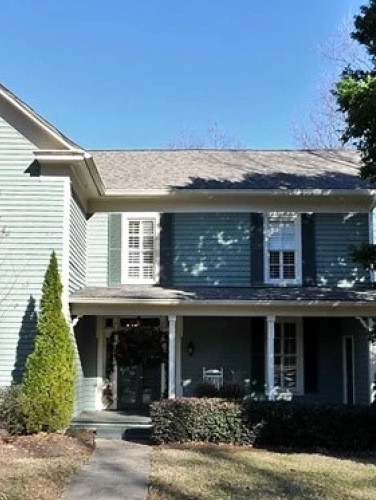
Grier-Furr House
(ca. 1877-1888)
The curious history of the Grier-Furr House includes a mystery, cotton farming, patent medicine, and perhaps a bit of bootleg liquor.
500 West John Street, Matthews, NC 28105
The Grier-Furr House is a bit of a mystery. Local legend says that Eli C. Grier built this house for his son Julius and his daughter-in-law Jennie, perhaps in 1877 or 1878, but there is no extant evidence to confirm that information. In fact, according to public record, E.C. Grier never owned the property. The earliest deed reference to this property is 1883, which records the purchase of two tracts by W.B. Arrowood from D.C. and Mary Shaw and from the estate of J.V. Houston. Arrowood in turn sold the properties to Julius S. Grier in 1901.
Property Quick Links
E.C. Grier lived in the Providence township and owned a house similar to the Grier-Furr House, both reflecting the Folk Victorian architectural style with Greek Revival details. E.C. was a prosperous farmer. Before the Civil War, he owned a 330 acre farm worth $4,000. At least eight enslaved persons labored on his farm. The war does not appear to have been particularly detrimental to E.C. He served in the North Carolina state legislature during the war and by 1870, his farm increased in size (to 450 acres) and value ($10,000), and he worked the farm using $500 worth of farm machinery. Like other farmers in the Piedmont, his crop emphasis was corn and cotton.
E.C.’s son Julius was the second of eight children and the eldest child of E.C. and Lydia Grier. Julius owned a 162 acre farm in the early 1880s but by 1900 he had moved to the Morning Star township where he continued to farm but also worked as a furnishing merchant, supplying farmers with seed, fertilizer, agricultural implements, dry goods, and ginning facilities. In that capacity, Julius frequently arranged crop liens and credit with some of his customers who could not afford to pay cash for their supplies. He also served as an agent for cotton distribution between farmers and the textile industry. As a farmer, Julius relied heavily on cotton as his cash crop, using tenant farmers to plant and pick the crop.
Julius Grier died in or about 1910 of unknown causes. His family sold the John Street house to Henry Baxter Furr in 1917. Furr lived there until his death in 1953, and his family kept the property until 1977. Henry Furr earned his living through a variety of enterprises, including as an herbalist, a traveling salesman for Rawley patent medicine products, and reputedly as a purveyor of bootleg alcohol. Beneath the front stairs of the house is a small closet that locks from the inside where someone could sit with the contraband and lock the door from the inside – giving the impression that the door was stuck – in order to hide illegal alcohol from government inspectors. After Henry’s death, his family converted the property into a boarding house. The house could accommodate up to five families; even the front porch was enclosed for boarders. The residents shared a single unheated bathroom.

